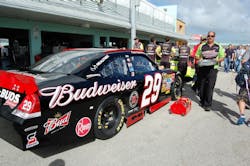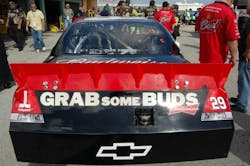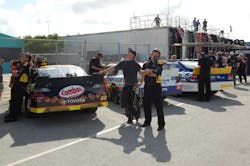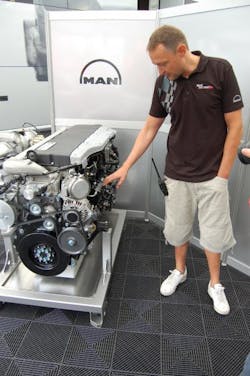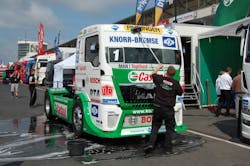Take for example the cost breakdown for a NASCAR race team: engines can cost anywhere from $45,000 to $80,000; each tire $350 to $450 a pop; and the car chassis itself clocking in around $70,000.
Truck racing can be just as expensive, too. I took a sojourn behind the scenes of the European truck racing circuit back in July this year and discovered that the top teams spend 1.2 million Euros per year (roughly $1.63 million U.S.) on vehicles, engines, support staff, etc. While the small independent truck racing teams can get by on 30,000 Euros (equivalent to $41,000) annually, that isn’t chump change if it’s mainly coming out of your own pocket.
Obviously, the main attraction of car and truck racing is the adrenaline-surging thrill of high speed, thunderous noise, and the shared experience with tens of thousands of like-minded fans of both vehicular sports.
[But oh it’s a bit scary to be in one at high speed … as this fun commercial from earlier this year illustrates.]
Yet there’s an understated – and very pragmatic – benefit to car and truck racing, as well; one primarily centered on the extreme engineering insight such sports provide makers of everyday components for both types of vehicles.
Istvan Kapitany (below at right), president of Shell’s Commercial Fuels and Lubricants Americas division, noted recently that the automotive industry has always relied upon motorsports-borne technology as an innovation test-bed for road cars; applying lessons from the track to the road, to develop products that power and protect motorists globally.“With fewer regulations and cost considerations than the real world, motorsports is an open test ground for pushing industry boundaries and generating ideas or solutions that could have far-reaching impact on the future of mobility,” he explained. “For engine oils, the lower the viscosity of the oil, the less fuel you need to power your engine. The challenge is to determine the lowest viscosity that still provides the right level of engine protection, durability and performance.”
And car racing provides just such a “test bed” for Shell and other lubricant makers to test out their latest concoctions in some of the most extreme vehicular conditions found anywhere on the planet.
[To view some "behind the scenes" photos of a NASCAR race, please click here.]
Kapitany pointed out that motorists use decades of race-inspired technology ranging from full rear-view mirrors and performance tires to engine-cleaning fuel additives and advanced lubricants. He added that Shell bridges both worlds with a diverse portfolio of race teams, drivers and series like IndyCar, NASCAR, MotoGP and Formula One, working in close technical alliances across an array of automotive and engine manufacturers.
OK, so what exactly are suppliers like Shell working on in the car racing arena that translates into everyday motor vehicle design?
Start with fuel efficiency, for example. In racing, Kapitany said fuel efficiency can mean the difference between winning and not finishing the race – and thus why track-tested components such as smaller turbo-charged engines are making their ways into everyday auto and light trucks.
Here’s an example: When the IZOD IndyCar Series changed its chassis and moved to a twin-turbocharged V6 engine for its ethanol-burning race car last year, Chevrolet not only re-entered the series, it wanted to test smaller, turbo-powered engines for fuel economy in road cars.Yet to optimize its IndyCar engine performance, Chris Berube, Chevrolet Program Manager-IZOD IndyCar Series said the OEM desired an oil comparable with those used for racing in the past, but not a “custom blended” variety – they wanted an “off the shelf" engine oil.
“Any oil we used needed to be a 100%, off-the-shelf store-bought oil,” he explained. Thus the engine oil bubbling through Chevy’s twin-turbocharged V6 engines competing in the IZOD IndyCar Series this year – including the world-famous Indianapolis 500 – is the exact same formula consumers can purchased for their vehicle from their local auto supply store.
Yet new hardware, like turbochargers, can also have an unintended impact on other parts of a vehicle, Shell’s Kapitany stressed, which is why Shell tests and evaluates the fuel, engine oils, gear oils, coolants, transmission fluids and greases it supplies the market.“For example, turbos run hotter which can affect lighter weight components, so we adjust [engine oil] formulations to better adapt to temperature variations,” he said. “Also alternative fuels may cause contaminants in engine oils, so Shell's scientists design oils with better seal compatibility, while start/stop motors can allow oil to 'bake' in hot spots.”
On another front, lightweight plastics, composites and other materials are replacing heavy steel components used in exteriors and interior applications like dashboards to help improve the race car’s fuel economy footprint – another engineering trend making its way into the “regular” car and light truck world.
Finally, start/stop ignition systems to conserve fuel, along with clutchless transmissions with computerized gear shifting to minimize inefficient errors, all got their developmental start out on the race track and again are making their way into consumer-grade vehicles – technology thoroughly tested in the ultimate of harsh conditions so engineers know it will hold up.
That same dynamic holds true as the reason why Europe’s heavy truck OEMs are deeply involved in the truck racing world.Indeed, Artur Klein (seen at left) – who serves as racing team manager for the engine research division of Europe’s MAN Truck & Bus AG – told me this summer that three weekends of truck racing will reproduce roughly three to four years worth of commercial truck life, in no small part due to the higher horsepower (2.5 times greater than what’s normally generated by on-highway engines) during extreme acceleration and deceleration maneuvers.
[To view some behind-the-scenes photos of European truck racing, click here.]
In pure numbers, he said those three weekends of truck racing equates to about 200,000 to 300,000 kilometers worth of operational life; roughly equivalent to 124,000 to 186,000 miles in the U.S.
Indeed, many European trucking OEMs – especially engine makers – sponsor truck racing teams purely because the sport offers them a way to test their products in extreme conditions. “In a very short time, we can see if there’s a problem,” Klein told me.He explained that each race team gets two engines – usually around 12.5 liter displacement – and that halfway through the season, the OEM conduct a complete teardown on the one that’s done all the work to that point to see how it’s holding up. After damaged components are replaced, the engine is rebuilt and given back to the team.
So what do engine makers learn? Well Klein told me that four years ago MAN discovered the metal material for some of its ball bearings didn’t withstand the strain well, and that the tolerances for its piston rod connector pins weren’t up to snuff either. So it made changes to both of them make its production-line on-highway models more robust as well as help them last longer than before.
“Every year we learn something new that helps us make our on-highway engines better,” he stressed. “That’s why we’re involved in truck racing.”
Just goes to show that there’s a very pragmatic and beneficial side to all those cars and trucks zipping around asphalt and concrete tracks at high speed on the weekends – something that’ll help generate far fewer pangs to the conscience when enjoying such motorized spectacles, I suspect!
